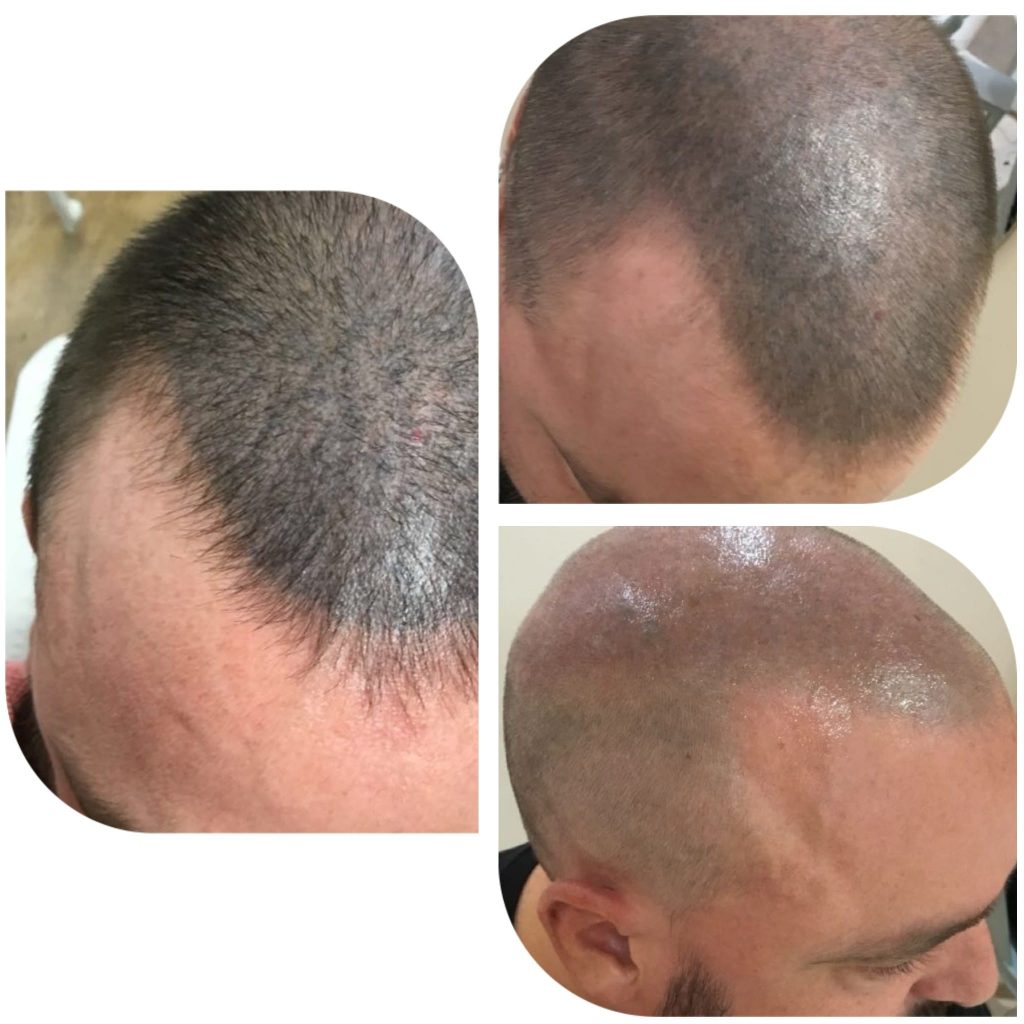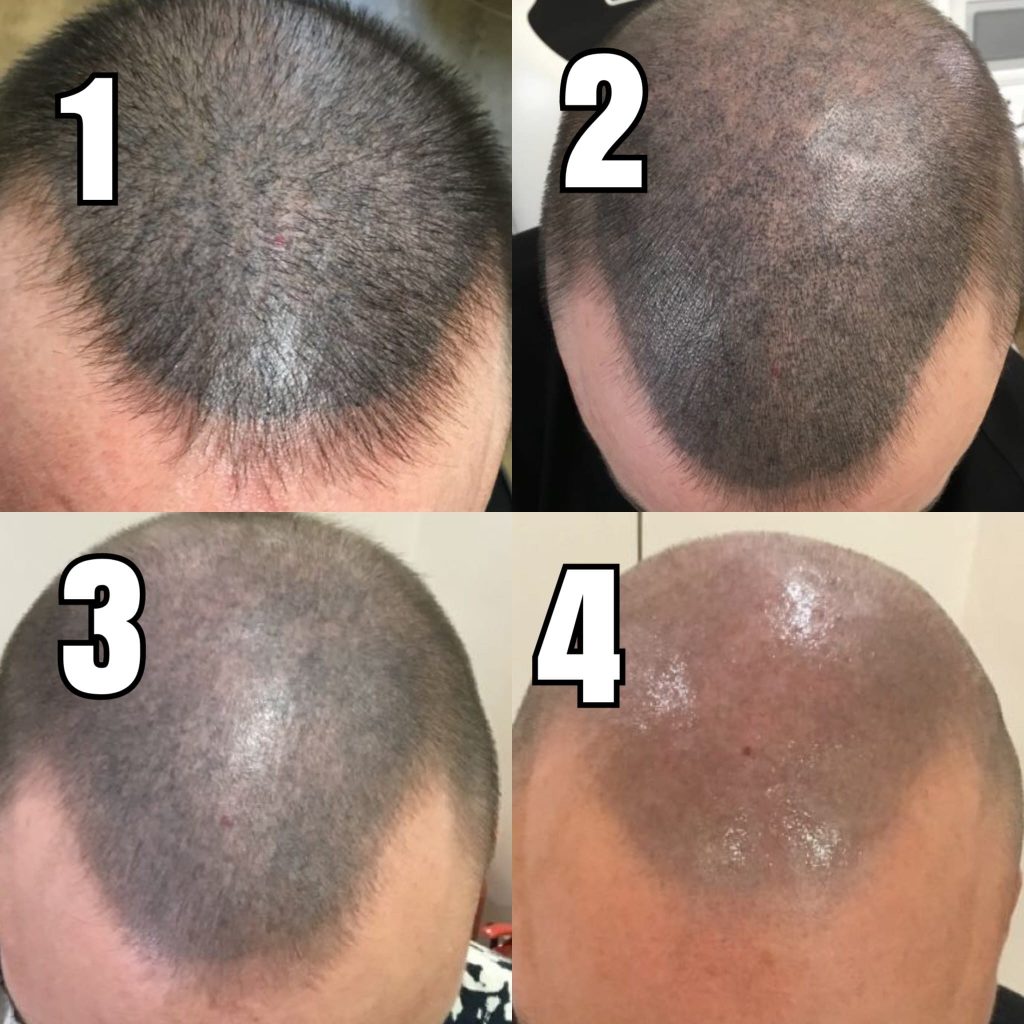How to Fade Scalp Micropigmentation When It’s Turned Out Too Dark
Estimated reading time: 7 minutes

Scalp micropigmentation (SMP) is a truly remarkable solution for hair loss, offering a realistic simulation of hair follicles through the use of tiny, strategically placed pigments. However, there are times when the results can turn out darker than desired. This can leave you feeling like you’re worse off than before you had the treatment done, not to mention a lot poorer! I’ve been doing scalp micropigmentation removal for over 15 years. I will share here what I have learned in order to help you make the correct decision to rectify your situation.
What is Scalp Micropigmentation?
Scalp micropigmentation involves the application of pigments to the scalp, mimicking the appearance of hair follicles. The most used pigment is a diluted version of the carbon black used by body tattooist. This method has proven effective as the dilution of the pigment allows it to take on the undertones of the scalp making it look more natural. The intensity and depth of the pigment can sometimes result in a darker look than anticipated due to several factors, such as pigment concentration, skin type, and the initial design. Also, a less experienced technician could potentially have a much heavier hand that may lead to blow outs of pigment under the skin.
Methods to Fade Scalp Micropigmentation

1. Natural Fading
The simplest and least invasive method is to let the pigment fade naturally. Over time, exposure to sunlight, the body’s immune response, and regular washing will gradually lighten the pigment. This process can take several months, but it’s a viable option if you prefer not to undergo additional procedures. It’s important to be realistic as to how much SMP will fade naturally. If your SMP is like picture 1 and 2 on the left and older than 2 years. It will not fade. Pictures 3 and 4 will probably fade more as it has a lower ink concentration. Anything there after 2 to 3 years is permanent ink.
2. Exfoliation
Regular exfoliation with sea salt can help speed up the fading process. Use a gentle exfoliating scrub designed for the scalp. This method works by removing the top layer of skin cells, which can help lighten the pigment over time. Be cautious not to scrub too hard, as this can irritate the scalp and cause further issues.
3. Saline Removal
NON laser removal is a popular method for lightening SMP. It involves using a saline solution to draw the pigment out of the skin. A technician will apply the solution to the treated area, which helps break down the pigment particles and promotes their natural removal by the body.
Procedure:
- The technician uses a machine similar to the one used for tattooing.
- They apply the saline solution to the scalp, which is absorbed by the skin.
- The solution lifts the pigment to the surface, where it is eventually shed with the skin cells.
This method typically requires multiple sessions for significant fading.
The only time I would recommend this method being used is if there has been titanium based pigment tattooed on the scalp. This happens when someone has tried to “fix” the problem by adding skin coloured pigment. In other words, has made a mess. This is a very invasive method and it takes weeks to fully heal in comparison with the 3 to 7 days that laser heals. Also, the after care of this method is very difficult as it requires you to keep the area dry for 10 days.
I do not recommend this method for SMP removal unless it’s an emergency.
4. Laser Treatment to Fade Scalp Micropigmentation
This is where the magic happens in my opinion when removing or lightening SMP. Laser removal is one of the most effective methods for fading SMP. It works by targeting the pigment particles with laser light, breaking them down so the body can absorb and eliminate them. This method is precise and can achieve noticeable results faster than other techniques.
An experienced practitioner such as myself will also be able to target specific blowouts and fade the SMP gradually so that no further tattooing treatments are needed. Many people want the SMP off so that they can have it re done but soon realise that I can tweek the removal in such a way that I leave them with the desired shade. Further SMP treatments may be needed a few years down the road but I can usually get it right for my clients.
How Laser SMP Removal works:
- A specialist will assess your scalp to determine the appropriate laser settings.
- The laser targets the pigment, causing it to shatter.
- The body’s immune system then removes the fragmented particles.
Laser treatment may cause some discomfort and usually requires multiple sessions. Like any treatment it is essential to consult with an experienced technician to minimise risks and ensure the best results. You can book a free video consultation with me HERE.
5. Chemical Peels
Chemical peels involve applying a chemical solution to the scalp to remove the outer layers of skin. This process can help lighten the pigment by shedding the skin layers that contain the pigment particles.
Chemical Peel Procedure:
- A professional applies a chemical solution to your scalp.
- The solution causes the top layers of skin to peel off over the next few days.
- New, lighter skin layers replace the peeled skin.
Chemical peels should be performed by a professional to avoid complications such as burns or excessive irritation.
6. Home Remedies
Several home remedies can aid in fading scalp micropigmentation, though they are generally less effective than professional treatments. Some options include:
Aloe Vera: Known for its soothing properties, aloe vera can help promote skin regeneration, which may assist in fading pigment over time. Apply aloe vera gel to your scalp and leave it on for 20-30 minutes before rinsing.
Lemon Juice: Lemon juice has natural bleaching properties. Mix lemon juice with a bit of water and apply it to the scalp. Leave it on for about 10 minutes before rinsing. Be cautious with lemon juice, as it can be quite acidic and may cause irritation.
Vitamin E: Vitamin E oil can promote skin healing and regeneration. Massage the oil into your scalp regularly to support the fading process.
7. Seek Professional Advice
If your SMP is significantly darker than desired, it’s wise to consult with a professional who specialises in scalp micropigmentation correction. They can assess your situation and recommend the most suitable method for fading the pigment. They might combine several techniques to achieve the best results.
Preventing Future Issues
To avoid ending up with overly dark SMP in the future, consider these tips:
1. Choose an Experienced Technician
Select a skilled and experienced SMP artist. Review their portfolio, check client testimonials, and ensure they have a good track record of achieving natural-looking results.
2. Discuss Your Desired Outcome
Clearly communicate your expectations with the technician. Show them photos of the look you’re aiming for and ensure they understand your preferences regarding the pigment shade and density.
3. Start Light
It’s often better to start with a lighter application, as it’s easier to add more pigment later than to remove excess. Discuss with your technician the possibility of starting with a lighter shade and gradually building up to your desired look.
4. Follow Aftercare Instructions
Proper aftercare is crucial for the best results. Follow your technician’s aftercare instructions meticulously to ensure the pigment sets correctly and to avoid complications that can affect the final colour.
Fading overly dark scalp micropigmentation can be a tricky process and getting a professional involved early on is important. When I have a video consultation I give the potential client all of their options including home removal and exfoliation. Whether you opt for natural fading, professional treatments, or home remedies, it’s important that you choose what is best for you.
If you wish to have a free video consultation with me you can book HERE.

